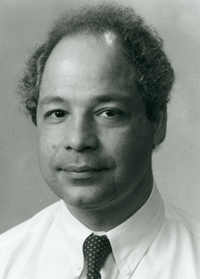In July 2023, we changed our name from AACC (short for the American Association for Clinical Chemistry) to the Association for Diagnostics & Laboratory Medicine (ADLM). The following page was written prior to this rebranding and contains mentions of the association’s old name. It may contain other out-of-date information as well.
 1987 AACC Lectureship Award
1987 AACC Lectureship Award
Lance A. Liotta, M.D., Ph.D. is the recipient of this year’s AACC National Lectureship Award.
Dr. Liotta was born in Cleveland, OH, in 1947. He obtained his undergraduate training at Hiram College in Hiram, OH, graduating in 1969. From 1969 to 1976, he completed an M.D.–Ph.D. graduate program at Case Western Reserve University. For his Ph.D. thesis, Dr. Liotta developed a new experimental model to study cancer metastases. Dr. Liotta originated in vitro and in vivo experimental systems to quantitatively study specific events during the metastatic process, in particular the shedding of tumor cells into the circulation and the growth rate and death rate of micrometastases. He also developed a deterministic and stochastic mathematical model of the stages of metastases. A critical observation emerged: The major rate-limiting step in tumor cell extravasation was interaction of the tumor cells with the vascular basement membrane. To study the mechanisms involved in this event, Dr. Liotta isolated whole basement membranes from murine lung and studied the interaction of metastatic tumor cells with this extracellular matrix material. He found that aggressive tumor cells attached to, and degraded, the isolated basement membrane.
After graduating from Case Western Reserve, Dr. Liotta went on to obtain his residency training in anatomic pathology at the National Cancer Institute, Laboratory of Pathology, NIH, Bethesda, MD. He is board certified in anatomic pathology. At the NIH, Dr. Liotta continued and expanded his studies of the biochemical mechanisms involved in tumor cell invasion and metastases. He developed a three-step hypothesis on examination of tumor cell interactions with the extracellular matrix from which he could identify, then purify, tumor cell-derived metalloproteinases which specifically degrade basement membrane type IV and type V collagens. The concentration of these proteinases correlates with the metastatic phenotype in a variety of experimental systems. He mapped the binding domains of the laminin molecule (a glycoprotein uniquely found in basement membranes). Furthermore, his group identified for the first time a high-affinity cell membrane receptor for laminin. The existence of a cell receptor for matrix molecules has wide implications in development, differentiation, and neoplasia. Dr. Liotta’s group has cloned the gene for the human laminin receptor and used this information to predict the amino acid sequence of the binding domain on the receptor for laminin. The importance of laminin and its receptor in metastases from circulating tumor cells was verified by experiments in which fragments of the laminin ligand were shown to abolish metastases in animal models.
Dr. Liotta’s group was the first to propose the concept of, and purify, the autocrine motility factor (AMF). This factor is secreted by tumor cells, binds to a receptor on the producer cell, and profoundly stimulates cell motility. AMF is distinct from known growth factors. Its mechanism of action involves cell membrane G proteins and lipid methylation. Dr. Liotta’s group was also the first to develop a genetic model of metastases induction involving the transfection of defined genes, including the ras family oncogenes, into non-transformed cells which induce the complete metastic phenotype. Prior to this model, high and low metastic cell lines could be obtained only by selection from heterogeneous tumor cell populations. All of these research accomplishments have been confirmed by scientists outside of Dr. Liotta’s group.
Dr. Liotta received the Warner-Lambert/Parke-Davis Award from the American Association of Pathologists in 1984 and the 6th Annual Rhoads Award from the American Association of Cancer Research in 1985 for his research on cancer metastases.
Dr. Liotta holds more than 12 patents for inventions derived from his government work as well as inventions he developed as a private citizen. One of the latter patents has been licensed by a Minneapolis-based company, Genesis Labs, Inc., which is developing the technology for a rapid one-step immunoassay.
Dr. Liotta is currently the chief of the Laboratory of Pathology and chief of the Section of Tumor Invasion and Metastases, Division of Cancer Biology and Diagnosis, National Cancer Institute, NIH.